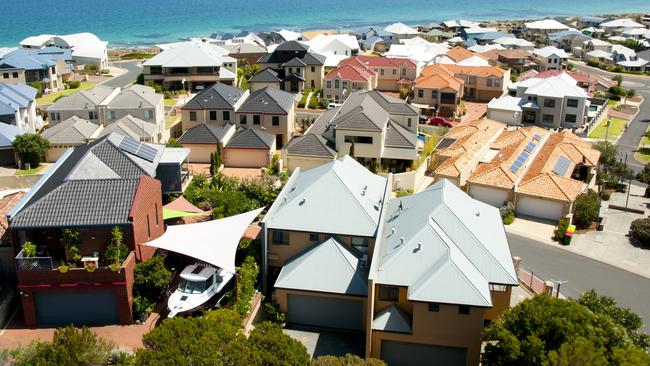House prices tipped to fall 10% in 2023: CBA
The housing market is in the twilight of an incredible boom but higher interest rates are in the pipeline, CBA says.

Higher interest rates driven by increased employment and wage growth expectations will lead to a downward correction in national house prices in 2023, experts say.
Average national house prices will peak in late 2022 before falling by around 10 per cent in 2023, according to new research from CBA released on Monday.
Australian dwelling price growth is forecast to moderate over the first half of next year on higher fixed mortgage rates, affordability constraints and natural fatigue after a period of extraordinary price gains, CBA Economics research predicts.
The forecasts are centred around expectations the Reserve Bank will raise the cash rate to 1.25 per cent by the third quarter of 2023, from its current historic low of 0.1 per cent.
“The cash rate is forecast to lift because the economy will be at full employment and
annual wages growth will have pushed to the desired level of 3%,” the report said.
“The extent to which prices correct lower will depend in large part on the speed and magnitude to which the RBA lifts the cash rate”.
For now, the forecasts are for Sydney and Hobart house prices to fall by 12 per cent in 2023, while Melbourne and Canberra dwellings cost 10 per cent less.
Brisbane, Adelaide and Darwin homes would be 8 per cent cheaper.
House price corrections will be larger, down 11 per cent, than that of units, a 7 per cent decline.
“The Australian housing market is in the twilight of an incredible boom that has been fuelled by record low mortgage rates,” the report said.
Home prices have increased at an extraordinary pace over 2021 with annual growth accelerating to 20.8 per cent in October. Dwelling prices nationally will end 2021 up by about 22 per cent.
“The phenomenal lift in prices is not over yet given dwelling prices are still rising briskly in most capital cities. But near term indicators of momentum coupled with the recent move higher in fixed rate mortgages suggest that conditions will moderate from here.”
The outlook means further home lending restrictions from the Australian Prudential Regulation Authority are unlikely to be needed, CBA’s analysis concludes.
“A further tightening in macro‑prudential policy looks unlikely in our view given higher fixed mortgage rates will deliver APRA the desired cooling in the market.”
Based on currently available data, the rate of price growth in the property market appears to have already started to slow following a peak around the middle of this year, said Cameron Kusher, director economic research at PropTrack, the research arm of realestate.com.au.
“Firstly, the adjustment in prices due to lower mortgage rates appears to have just about run its course.
“Secondly, households have been dedicating more of their income to housing costs due to lockdowns and border closures, but with lockdowns and border closures now behind us it is likely less income will be dedicated to housing and more will be spent on things like social activities and travel.”
Last week ANZ economists forecast national average house price growth would slow in 2022 before a slight fall (down 4 per cent) in 2023.
“House price growth looks likely to peak in November or December 2021 at just above 21 per cent,” ANZ senior economists, Felicity Emmett and Adelaide Timbrell said in their report ‘Australia’s Housing Rolling Over’.
“But a slowdown is in sight, with tighter credit, rising fixed mortgage rates and a large increase in stock on the market combined with decreased affordability all set to dampen price growth in 2022.
“In 2023, we see prices falling modestly as higher fixed rates really start to bite.”
In his update in October, Westpac economist Bill Evans also flagged house prices “levelling out over the course of next year before moving into a correction phase in 2023”.
Westpac’s forecasting a 5 per cent decline in national house prices with dwellings in Sydney and Melbourne experiencing a sharper 6 per cent decrease.
“The wild cards are around investor activity and potential impacts from an extended period of slow population growth,” Mr Evans said.
“But for now, the market has weathered the latest COVID disruptions very well and price momentum has held, prompting us to revise up the near-term outlook for prices before a correction phase begins in 2023 and likely extends into 2024.”
NAB’s quarterly property survey, released in October, predicted a similar pattern of growth in prices across capitals, with the pace gradually slowing through the last quarter of this year and into 2022.




To join the conversation, please log in. Don't have an account? Register
Join the conversation, you are commenting as Logout